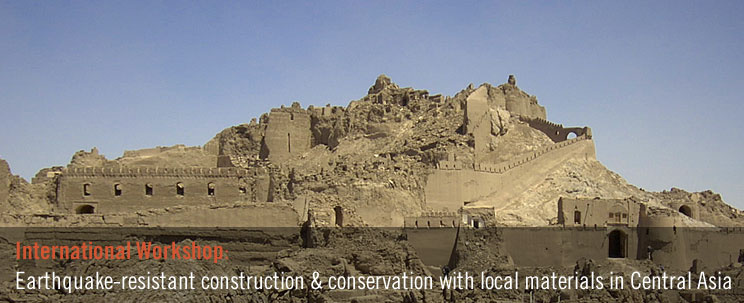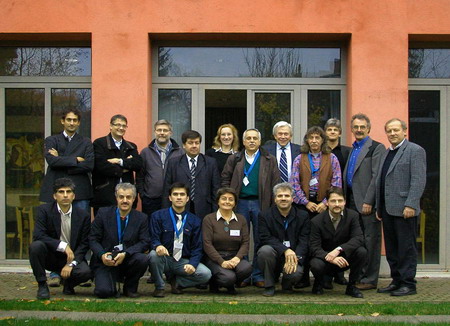
International workshop: “Earthquake-resistant construction and conservation with local materials in Central Asia”
The follow-up workshop continues the series of meetings after the devastating earthquake in Bam in December 2003 in which a staggering 27,000 people lost their lives.
At the end of the previous Bam Workshop in April it was concluded that a follow-up workshop should take place in Germany directly after the LEHM 2004. The presence of specialists at the LEHM 2004, particularly of those with experience in traditional earthen building and conservation techniques in seismic areas, was an opportunity to continue and build upon this dialogue between Iranian and international specialists with a view to discussing further appropriate activities for the “rebuilding” of Bam.
The workshop took place on the 1st and 2nd November 2004 in Weimar and was organised by the Bauhaus University Weimar in cooperation with the Dachverband Lehm e.V.
25 international experts from Germany, Iran, Uzbekistan, Turkey, the Lebanon, Sweden, the USA and England took part in the workshop and discussed cooperation possibilities between institutes, companies and organisations for earthquake resistant building using locally available building materials.
The workshop was opened by Dr. Werner von Trützschler, General Secretary of ICOMOS Germany and was also accompanied by a poster presentation on steel frame construction and earthen fill material. A workshop brochure is planned for 2005. The workshop was supported by earthen building and steel building firms with expertise in building in earthquake-prone regions.
The region of Central Asia has a very long tradition in building with earth reaching back thousands of years. Today, earth is still a common building material in urban regions as well as in rural areas. A number of traditional earth building techniques with different local names have developed over the years but these generally have poor earthquake resistance. However, Central Asia is one of the regions most prone to earthquakes in the world.
A large number of disastrous earthquakes in the region have been the cause of tens of thousands of deaths. The last earthquake in Bam in south east Iran on the 26th December 2003 cost more than 27,000 people their lives, that is more than a quarter of the whole city’s population. A further 40,000 inhabitants were left injured and/or homeless. Historic monuments built of earth located in and around Bam were either totally destroyed or considerably damaged by the earthquake, the most important of them the 2000 year old Arg-e-Bam, the symbolic citadel of the city of Bam.
Three weeks before the earthquake shook Bam, the terra 2003, the 9th International Conference on the Study and Conservation of Earthen Architecture, took place in the city of Yazd, about 400 km NW of Bam. As part of a post-conference trip a group of conference participants visited the Arg-e-Bam. For earth building specialists, the earthquake therefore had special importance, and in addition to the sympathies shared across the world for victims of the earthquake, the specialists wish to help contribute to the reconstruction of the City of Bam and to improving its earthquake resistance. A special workshop was held in April 2004 in Bam, organised and supported by the ICHO, UNESCO and ICOMOS to initiate dialogue between Iranian colleagues and about 70 specialists from all over the world. The workshop in Weimar is continues this dialogue.
The workshop was organised by the Bauhaus University Weimar in cooperation with the DVL. The Bauhaus University Weimar has a long tradition of collaboration with specialists from Central Asia in the field of earthquake-resistant construction and conservation with local materials, particularly with earth. We would like to introduce this experience into the dialogue begun in Bam and to contribute to the process of “rebuilding” Bam.
Programme:
Monday, 01.11.04 10 a.m. – 6 p.m.
10.00 Opening addresses
(Bauhaus University Weimar, ICOMOS, RCCCR)
10.45 – 12.30 Session 1
Situation and activities after the 2003 Bam earthquake
D. Bumbaru, S.G. ICOMOS International:
The Bam earthquake and UNESCO-ICHO activities
R. Vatandoust, RCCCR Teheran:
10 Months after the December 26, 2003 Bam earthquake – a current
status report
R. Langenbach, M. Arch., Dipl. Conserv., Oakland, CA, USA:
Soil dynamics and the earthquake destruction of Arg-e-Bam
Discussion
12.30 – 14.00 Lunch break
14.00 – 15.45 Session 2
The rebuilding of Bam – possibilities of a German contribution
J. Schwarz, H. Schroeder, Bauhaus University Weimar
Investigations into earthquake resistant building with local materials
at the Bauhaus University Weimar (material and structural analysis
of historical/new earthen architecture, standardisation)
T. Friedrich, F. Werner, T. Swain, J. Schwarz, Bauhaus University
Weimar, W. Batzke, P. Nöthlich, Stahlbau Rudolstadt
SEQD-Steel EarthQuakeDesign using local materials – results of
a research Project between the Bauhaus University Weimar and Stahlbau
Rudolstadt
Discussion
Coffee break
16.15 – 18.00 Session 3
Earthquake damage of earthen structures - lessons and case studies (from other earthquakes and regions )
S.A. Chakimov , UsLITTI Taschkent; B.S. Nurtajev,
Institute of Geology & Geophysics Tashkent, Uzbekistan
Earthquake damage to earthen buildings in Usbekistan ( Central Asia)
Ch. Kaufmann, T. Langhammer, J. Schwarz, Bauhaus Univers.
Weimar
Evaluation of the earthquake resistance of masonry wall structures
on the basis of empirical and numerical data
S. Simon , Getty Foundation Los Angeles
Physico-mechanical behaviour of adobe-structures under seismic conditions
J. Gasparini, TU Berlin
The Earth Building Project of the TU Berlin in Mexico
B. Isik, TU Istanbul
The Disaster of Bam and Lab-research into the dissipation of energy
on existing earthen buildings
Discussion
19.00 Evening reception at the “Limona”
Tuesday, 02.11.04 9 a.m. – 12.30 p.m.
09.00 – 10.45 Session 4
The rebuilding of Bam – concepts for joint efforts at an international
level
R. Vatandoust, RCCCR Teheran
The Bam declaration – a timetable for future activities
Discussion
Coffee break
11.00 – 12.30 Closing session
closing documents
15.00 – 18.00
Visit of UNESCO World Heritage sites in the city of Weimar
Conference language: English
Conference location
Bauhaus Weimar University,
International Conference Centre, (IBZ)
Belvederer Allee 21,
D-99421 Weimar, Germany
Ms Brigitte Höser
brigitte.hoeser@staa.uni-weimar.de
Tel. +49 (0) 3643 885 510
Fax +49 (0) 3643 885 550

